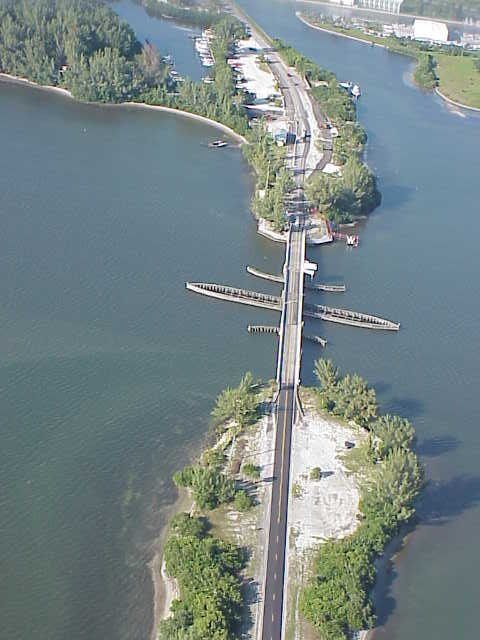GIBA and Boca Grande Causeway scores highly in annual maintenance report

Members of the Engineering Committee of the Gasparilla Island Bridge Authority met Tues., Jan. 23 to go over, literally, the nuts and bolts of the bridge.
Engineering Committee Chairman George Milne called the work of the committee “essential responsibilities. The work not only ensures access to Boca Grande but maximizes the “lives of the bridges and their viability.”
“Overall, the bridges, as relatively new ones, are in good shape,” said Milne. He reminded of the challenges of keeping a bridge in repair.
“We live in a hostile environment with all the salt,” said Milne.
The maintenance is not just the workings of the bridge and paint, but the structures, buildings and islands, all requiring a “level of diligence with our follow up.”
Steve Nappi, of the firm Hardesty and Hanover, was at the meeting to help committee members understand the report and answer any questions. After the meeting, he was soon spotted atop the drawbridge with staff, reviewing details.
“Annually, you are watching this [maintenance], so you are not getting into an area where you don’t want to be,” said Nappi.
H&H, based in New York but with local offices, was founded in 1887 by Dr. J.A.L. Waddell, an engineer who patented the first modern vertical lift bridge. The engineering firm, best known historically for its work on Chicago’s “L”, takes great pride in its work here, and even has the Boca Grande Causeway’s photo as a backdrop on its main corporate web page.
In the report on the condition and health of the bridge, this year, as in previous years, the Health Index of the bridge was over 95 percent, even with the hurricane damage. A “sufficiency rating” was much lower. That rating had nothing to do with the condition of the bridge, however. It takes into account other unfixable factors, including that there were no other detour routes to the island. That formula comes from the Federal Highway Administration, and it is used only to allocate funds for any future replacement.
The meeting reviewed items found and repaired since their recent October 2023 state inspection, and looked back at items from October 2022 that had been fixed.
Items from October of 2022 included slight corrosion of balance wheels. Some items were not mechanical or engineering. Each defect in the report had a before and after photo, to indicate that it had been fixed.
Items from October 2023 were addressed, including a missing tide chart and a clearance gauge light. A guardrail scrape from an errant motorist created a need for re-galvanization. Vegetation had grown under one pier of the south bridge. The inspection report also mentioned that couplings have been “clicking” on startup, but the report determined that this sound “can be considered normal operations.”
One addressed in the discussion were a few missing nuts, which the inspection confirmed that they had been missing since installation.
Advisory Member Ron Drake asked after the missing nut.
“The nut’s not required on that bolt,” said Nappi. The bridge had tried to put nuts on, but the threads did not fit.
The group also discussed painting schedules. The last paint study on the bridge was detailed, at 93 pages. Currently, the bridge employs one full-time person who is painting at all times to try to keep ahead of it any issues that he can reach without a barge, going south to north.
“Roger does a good job of staying on top of that,” said Executive Director Kathy Banson.
After the presentation, GIBA hired H&H to perform a long-term life-span and maintenance report for the bridge, to help anticipate future repairs and help consolidate and build a work schedule of areas of vulnerability. The group unanimously approved that proposal for $15,000. The bridge has a 75-year life span, and efficiencies can be gained when repairs, most particularly painting, is grouped and scheduled.
The committee also reviewed a proposal by DMK Associates to make specific recommendations related to Hurricane Ian and water intrusion that are ongoing, not only the bridge house, but maintenance and administrative buildings, indeed the whole complex. Items included water intrusion on the administration building, and a generator that is open to the environment and salt air.
“The bridge staff needs a long term plan,” said Banson.
The cost is estimated to be $132,500. Part of the need for the specific plan for intrusion fix items are not things that staff can fix, and will require specific bids from contractors. When improvements are properly specified, GIBA can then send the items out for bid with the knowledge that the lowest qualified bidder, which they are required to take, has all the requisite specifications.
“Our maintenance guys have bought up every tube of caulk within miles,” said Banson.
President Ginger Watkins agreed that it would be a good idea. Members asked to amend the bid, with an upwards adjustment of the number of meetings they would attend, and an increase in the contractor’s liability insurance needed.
“Lets have a plan that knows what’s going to work.” said Watkins. The committee voted to go forward with a proposal from DMK Associates Vice President Jeffrey R. Raykos.









